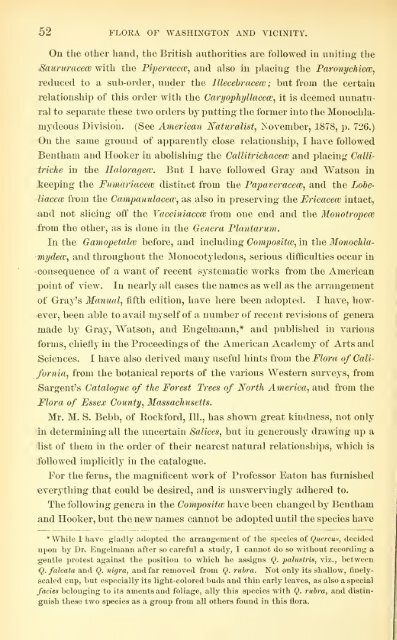Bulletin - United States National Museum - Smithsonian Institution
Bulletin - United States National Museum - Smithsonian Institution
Bulletin - United States National Museum - Smithsonian Institution
You also want an ePaper? Increase the reach of your titles
YUMPU automatically turns print PDFs into web optimized ePapers that Google loves.
52 FLORA OF WASHINGTON AND VICINITY.<br />
On the other hand, the British authorities are followed in uniting the<br />
Saururacem with the Piperacece, and also in placing the Paronychiece,<br />
reduced to a sub-order, under the lUecehracecc ; but from the certain<br />
relationship of this order with the CaryophyUacew, it is deemed unnatu-<br />
ral to separate these two orders by putting the former into the Monochla-<br />
mydeous Division. (See American Naturalist^ >;ovember, 1878, p. 726.)<br />
On the same ground of apparently close relationship, I have followed<br />
Bentham and Hooker in abolishing the Callitrichacew and placing Calli-<br />
triche in the Haloragew. But I have followed Gray and Watson in<br />
keeping the Fumariacece distinct from the Papaveracece, and the Lobe-<br />
liacew from the Canipanulacew^ as also in preserving the Ericaceae intact,<br />
and not slicing off the Vacciniacew from one end and the Monotropece<br />
vfrom the other, as is done in the Genera Plantarum.<br />
In the Gamopetalm before, and including Gompositce, in the Monochla-<br />
mydece, and throughout the Monocotyledons, serious difiSculties occur in<br />
consequence of a want of recent systematic works from the American<br />
point of view. In nearly all cases the names as well as the arrangement<br />
of Gray's Manual, fifth edition, have here been adopted. I have, how-<br />
ever, been able to avail myself of a number of recent revisions of genera<br />
made by Gray, Watson, and Engelmann,* and published in various<br />
forms, chiefly in the Proceedings of the American Academy of Arts and<br />
Sciences. I have also derived many useful hints from the Flora of Cali-<br />
fornia, from the botanical reports of the various Western surveys, from<br />
Sargent's Catalogue of the Forest Trees of Worth America, and from the<br />
Flora of Essex County, Massachusetts.<br />
Mr. M. S. Bebb, of Eockford, 111., has shown great kindness, not only<br />
in determining all the uncertain Salices, but in generously drawing up a<br />
ilist of them in the order of their nearest natural relationships, which is<br />
ifollowed implicitly in the catalogue.<br />
For the ferns, the magnificent work of Professor Eaton has furnished<br />
^everything that could be desired, and is unswervingly adhered to.<br />
The following genera in the Compositce have been changed by Bentham<br />
and Hooker, but the new names cannot be adopted until the species have<br />
* Wliile I have gladly adopted the arrangement of the species of Qiiercus, decided<br />
upon by Dr. Engelmann after so careful a study, I cannot do so without recording a<br />
gentle protest against the position to which he assigns Q. palustris, viz., between<br />
Q. falcata and Q. nigra, and far removed from Q. rubra. Not only its shallow, finelyscaled<br />
cup, but especially its light-colored buds and thin early leaves, as also a special<br />
fades belonging to its amentsand foliage, ally this species with Q. rubra, and distinguish<br />
these two species as a group from all others found in this flora.

















